‘Manthiri Kumari’ (1950) movie – revisited
by Sachi Sri Kantha, December 21, 2021
Fellow MGR biographer R. Kannan’s comments to my previous part 62, received on October 4th, was as follows:
“You have discussed two difficult issues related to MGR. Annaism brought much flak. Most of what it said about nationalization and the right to recall were from earlier DMK manifestoes. Clearly, it did not measure up to the expectations of the Left much less the DMK which also suffered from the absence of doctrinaire rigor. MGR’s comments trying to explain it made it did more damage than good. R.M.Veerappan did not wear the tatoo. Hande did not. MGR backed off and made it voluntary following the protests. I think if Annaism is a mix of everything then most countries would qualify. Won’t they?”
My response to Kannan’s comment, sent the following day was,
“…’certainly not’. The countries where Muslims are in the majority (Africa, Middle East, and Asia) are not ‘democratic’ at all. Many are monarchies, or pseudo/crypto monarchies. Some play the ‘game’ of having elections. But, as a famous American playwright wrote, ‘It’s not the voting that indicates democracy, but the counting.’ Not only Islam, even the Asian countries where Buddhism is state-sponsored (Sri Lanka, Myanmar, Thailand, Vietnam. Cambodia, Laos) one cannot say that democracy prevails. In this respect, Japan is different.”
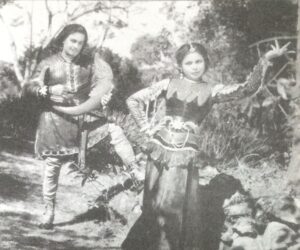
MGR and G. Sakunthala in ‘Manthiri Kumari’ movie
On Manthiri Kumari [The Minister’s Daughter] Movie
At the expense of losing the continuity from part 62, I revisit the landmark ‘Manthiri Kumari’ (1950) movie for two reasons; (1) I wish to add additional details that has come up in my re-reading of the autobiographical memoirs of the three principals involved in the movie – MGR, Karunanidhi and director Ellis Dungan. (2) an excellent documentary on Dungan’s life in Tamil Nadu had been posted in the Youtube, in early 2020 (see below). Previously, I had covered marginally, Manthiri Kumari movie, in parts 10 [about Modern Theaters’ boss Tiruchengodu Ramalingam Sundaram producing this movie, Aug 11, 2013; https://sangam.org/mgr-remembered-part-10/] and 51 [about MGR not considering this movie as one of his vital ‘turns’ in life, May 5, 2019; https://sangam.org/mgr-remembered-part-51/]. And also, in part 7 [about Ellis Dungan, Apr 1, 2013; https://sangam.org/mgr-remembered-part-7/]. In addition, I refrain from repeating the details offered by Kannan, about this movie, in his classic MGR biography book (2017).
Few months ago, I asked my 85 year old mother, who is in indifferent health for the past few years, about her memories of the first movie she saw in Point Pedro. [I wish, I should have asked this question 40 years ago!] Though her memories are playing tricks on her, still she answered my question. It was ‘Manthiri Kumari’. As this movie was first released on June 24, 1950 in Chennai, I presume that it would have been shown in Point Pedro, most probably in the following year, when my mother was 14 or 15. She still remembered a climax scene of the movie – Manthiri Kumari (character played by Madhuri Devi) being taken to a hill top by her husband and villain Parthiban (character played by S.A.Natarajan), singing ‘Varaai Nee Varaai’ [Come along – you come along], sung by Tiruchi Loganathan and Jikki.
The Youtube link for this song is https://www.youtube.com/watch?v=T32rZg8M4xs
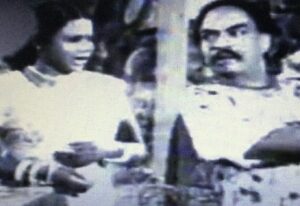
Kali N. Rathnam and his comedian partner C.T. Rajakantham, in ‘Mayavathi’ (1949) movie
In the storyline, though the villain plans to kill her after reaching the mountain top, Manthiri Kumari with premonition dupes him, and pushes him from the hill. But, my mother cannot remember who else accompanied her to the theater and the name of the theater in which she saw the movie. 70 years ago, an adolescent woman in Jaffna couldn’t have gone to a theater on her own. Now, I shouldn’t pick on my mother. Even I had forgotten, in which Colombo theater I first saw this movie, in it’s re-release in 1970s. My mother’s response was a pleasant surprise to me. In second half of 1960s, when I developed my MGR craze, it was my mother who tried her best to dissuade me from MGR’s movies and Tamil movie song books. These song books, then cost only 10 cents. In case, if I bought these and brought home, mother would have a look at it first, and without my knowledge, would dispose them silently! ‘Movies corrupt young minds’ was her only adamant rule at home then. I still remember her rebuke: ‘In the future, if you are starving, will your MGR come and feed you?’. But, she remembers that the first movie she had seen was that of MGR! Thus, being true to MGR’s ideals of mother worship, I revisit Manthiri Kumari again, in this chapter.
The Story Plot
The entry for the movie in the Enclopedia of Indian Cinema, provides the following details:
“One of the most popular Tamil films of the decade, continuing the post-Velaikkari (1949) engagement of top DMK personnel with cinema, scenarist Karunanidhi and star MGR. Shot near Salem in the hill resort of Yercaud, the film is baed on an 8th C. Tamil literary epic, a Buddhist text that, according to Mu. Varadarajan (1988), was a Buddhist propaganda work reflecting the rivalry between Buddhists and Jains in the 1st millennium AD. The original story, of which only 28 verses still exist, tells of a woman from the vaisya caste, a Jain by birth, who kills her husband when tries to murder her, and is eventually converted to Buddhism. While using its historical and literary references mainly as au authenticating force, the film replaces the Jain context with the Brahmin caste in line with DMK policy. Parthiban (Natarajan), the son of an imbecilic king’s royal priest (Nambiar), is committed to the art of banditry while wearing a Batman-type mask to discredit Veeramohan (MGR), a loyal general and lover of Princess Jeeva (Shakuntala). The minister’s daughter is Amudavalli (Madhuri) who tries to reform the treacherous son, marries but ends up killing him in self-defence. The nasty priest then kills her at the durbar. The songs proved enduring, esp. Vaarai…vaarai song sung by Trichy Loganathan for Parthiban as he leads Amudavalli to a hilltop to kill her. It is also a landmark in playback singer T.M. Soundararajan’s long career. Master Subbaiah, a teenage prodigy who died young, sings a song and appears briefly as a cowherd. The film also launched the enduring image of the famous screen villain Nambiar. Madhuri Devi provides the best performance as a sword-wielding, independently minded heroine who kills her own husband.”
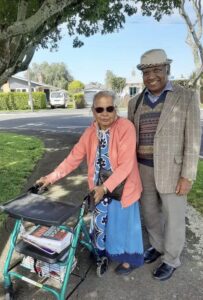
Sachi with his mother in Hamilton, New Zealand, Sept 2019.
A couple of corrections have to be noted in the above entry. When Manthiri Kumari was released in 1950, MGR was not a member of DMK party. Though it is true, that this movie introduced T.M. Soundararajan’s background voice to the fans, his contribution was not included in the title credits in the movie! [check the screen grab of the title credits for playback singers.] An extra ploughing the field, lip synched his song, ‘Annam idda veedile kannakol saathave’. The Youtube clip for this song is https://www.youtube.com/watch?v=-HfMh-yewXM
An excellent documentary on Ellis Dungan (1909-2001)
Ellis R. Dungan, who played a notable role in MGR’s elevation to the cinematic hero ranks, breathed last on Dec 1, 2001. Almost eighty minutes long, an excellent documentary on Ellis Dungan, the director of Manthiri Kumari, had been posted in the Youtube,dated Feb. 14, 2020, with the caption ‘An American in Madras’. The Youtube link is https://www.youtube.com/watch?v=gVw4Jtahy4s
As the commentary is in English, younger generation of expatriate Tamils (who are not fluent in listening Tamil) and non-Tamils can enjoy watching it. Those who are interviewed for this documentary (including actor Kamal Hasan, step-daughter of M.S. Subbulakshmi – Radha Visvanathan, film historian S. Krishnaswamy, Theodore Baskaran) speak in English, and the thoughts of elderly folks who speak in Tamil, have English subtitles.
Reference to MGR’s first movie Sathi Leelavathi, directed by Dungan appears at time frame sequence 8:18 – 8:30. Then, about the Mandhiri Kumari movie, one should check the time frame sequences 56:00 – 57:04. MGR’s toned-down delivery of Karunanidhi’s lines at a court scene is carried for one minute. This toned-down delivery was the trade mark of director Dungan (as the commentators in the documentary emphasize), who switched off the ‘stage-drama delivery style’ of actors to that of cinematic camera.
It is a popular refrain among Tamil movie fans for decades, that Sivaji Ganesan is a better actor compared to MGR. I beg to differ, though not to downgrade the talent and contribution of Sivaji Ganesan and his elders like M.R. Radha. Being talented stage actors, they imported the stage dialog delivery mode directly into cinema. Their verbal pyrotechnics with rolling lips and loud delivery, though entertaining for many fans, came to be outdated, as ‘over acting’. But, MGR (having received some prime lessons from Dungan, from his first movie in 1936, and appearing in minor roles for another 3 Dungan directed movies – Iru Sagothararkal, Jothi Malar and Meera) for almost 14 years, delivered subdued performances with moderation, as per Dungan’s direction, in Manthiri Kumari and quite a number of his early hero-role movies, such as En Thangai and Andhaman Kaithi. MGR was a quick study to differentiate the style of acting needed for a drama stage and cinema camera. There is little doubt that, if needed, he could deliver long tongue-twisting dialogs, but he rather focused on promoting his message via songs. In contrast to MGR’s performance in Manthiri Kumari, was the performance and high volume dialog delivery of villain actor S.A. Natarajan (who also entered cinema with strong stage background). The title credits for the movie lists Natarajan below MGR and Nambiar. Yet, quite a few Tamil reviewers and viewers make a silly error of tagging S.A. Natarajan’s performance as that of a ‘hero’ [or anti-hero] of the Manthiri Kumari. This is akin to saying that Brutus was the hero of Julius Caesar play, because he delivers 721 lines, compared to Caesar who has only 151 lines (and was assassinated in Act 3, Scene 1).
MGR’s note on ‘Manthiri Kumari’ shooting
In his autobiographical reminiscences, MGR passingly mentions about ‘Manthiri Kumari’ movie. But, it was not about the movie, but his first meeting and interaction with Puthur Nadarajan. A translation of his recorded reminiscence follows:
“I had the opportunity to meet him for the first time when I went to act in the ‘Manthiri Kumari’ movie produced by Modern Theatres. Those who work there and all the extras were scared of him. Few called him Puthur Nadarajan. Many called him as ‘Kuranku (Monkey) Nadarajan. It wouldn’t be an exaggeration if he was tagged as the first among the pet sons of the late Mr. T.R. Sundaram. There was a scene in ‘Manthiri Kumari’ in which, I was teaching sword fencing for the soldiers. The director was Mr. Dungan.
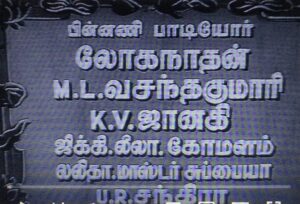
Title credits for Playback singers in ‘Manthiri Kumari’. Name of TMS is omitted!
The following day, a rehearsal of the fighting scene was arranged for him. As such, I was asked to attend the rehearsal. I was told that if the rehearsal was not to his satisfaction, Mr. Dungan would be dejected; as such, I was asked to attend the pre-rehearsal that evening. I went to the company’s premise. In the open ground, many were training. The trainer was Mr. R.N. Nambiar. (About him, I will write more later).
I went and performed what was requested from me. I also trained my friends, who practiced with me.
Then, Mr. N.S. Nadarajan came there. This is how, he addressed a friend of mine who was training with me. [He said] ‘Hey, Move over there. You, sloth! (This was his petting form of address.) Give me the knife. He is fighting like a sloth,’ and grabbed his knife forcefully. I was told previously by R.N. Nambiar that Mr. Nadarajan was a like a big roughneck. Until then, I was fighting without folding my verti, but carrying the lower end with one hand. Once he picked the sword, I folded my verti, and picked my sword for fencing. What was in the training book was thrust five or six times, block the thrusts, and finally the long thrust. These should be done with proper rhythm, like those who sing to the proper rhythmical beats.
Mr. Nadarajan began his thrusts at quick speed. They were rhythmical. Finally, he slipped in his rhythm, and with his full force thrusted for me to defend. Suppose if I was careless, my scalp and face would have split in half. It was not his intention to hit me like that. But, his usual hand reach was attuned to it. (It was said that when he thrusted, no one will stand up for him. They simply leave.)
As I was trained to be careful of such faulty steps, and how to block such thrusts, according to my instinct, I thrusted my sword. That’s all. At the same time, when his sword landed on mine, it slipped from his hand and flew a distance. When we picked it, it had bent like the English alphabet ‘S’. And the front end of the handle of my sword, had been crushed.” [end of chapter 101]
There is a story that Dungan treated MGR harshly during the shooting of Manthiri Kumari, which has been reported by Kannan. The source cited was a book by Vijayan, titled ‘MGR Kathai’ [MGR Story]. Reliability of this source is questionable. Neither MGR nor Dungan makes mention of such incident(s) in their autobiographies. In my reading, even if MGR had omitted it by design to hide his hurt pride, Dungan was not one to omit it, especially when it relates to MGR. This is because, Dungan had specifically included details of his interaction with M.S. Subbulakshmi during the production of Meera, and how he humiliated her in front of others (Of course, after receiving prior permission from Subbulakshmi’s husband Sathasivam), to bring out the best acting from her. To be fair by MGR, in his confessional autobiography, he had included countless incidents in his life where he was insulted.
Karunanidhi’s reminiscence about scripting ‘Manthiri Kumari’
Translated script of what Karunanidhi had reminisced, follows:
“Our family life began at Salem. We resided at a rented house in a street near the Salem fort. Mr. T.R. Sundaram had expressed his wish to make a movie from my drama ‘Manthiri Kumari’. I agreed and completed the story plot and movie script accordingly. Around that time, ‘Mayawathi’ movie released by them was losing money in box office. To recover the loss from that movie which was produced with a big budget, Mr. T.R. Sundaram decided to make ‘Manthiri Kumari’ with attentive care. They decided to fix the opening of shooting for this movie. An astrologer was invited to fix a day with good omen. I was introduced to him. I asked him: ‘Have you come to fix the time for opening shooting? ‘Yes’, he replied with a happy face.
I retorted, ‘Weren’t you the one who also fixed the time for opening shooting of the ‘Mayawathi’ movie too? He could only respond ‘Yes’, with a guilt-leaking face.
‘Manthiri Kumari’ produced under the direction of Ellis R. Dungan, and the overall supervision of Mr. T.R. Sundaram, generated a big revolution in Tamil Nadu, after it’s release. [We faced a] lot of opposition from theists and stage aggression from the opposition parties. There is a scene, with a line in which Partiban character as a bandit, pouts ‘Banditry is an art’. Forgetting the fact that it was depicted for a character in the movie, at the stage of opposition parties, I was implicated that the policy of the script writer [i.e., me] was also the same, and even if it’s fiction, is it proper for him to promote it to the state?
At the end, bandit Parthiban was killed, and ignoring this vital fact of how I had depicted this character, opposition parties attacked me and my party using the plot of ‘Manthiri Kumari’ as an instrument. Despite such opposition, this movie earned a big success. In every city it was screened, the movie earned big profits.”
One may wonder why the young Karunanidhi had to pick on the poor astrologer (even as a jest), who was earning his living. That particular astrologer was there as an invitee of the Modern Theatre’s boss Mr. T.R. Sundaram, and paid for his service. Even if that episode happened, Karunanidhi shouldn’t have been mean to insult the believers of astrology. Would he have courageously expressed his anti-astrology sentiments to Mr. Sundaram? Though Karunanidhi passingly mentions that he had been staging the Manthiri Kumari as a drama, additional details about this drama were missing. How popular was it in the stage? This should have been around the period, when DMK party was founded, around Sept 1949. What incidence sparked his inspiration for this play? Who played the four major roles of Veeramohan, Parthiban, Rajaguru and Amudavalli in the drama? These details have not been included in his autobiography.
Dungan’s thoughts on ‘Manthiri Kumari’
For its relevance on what he had written about MGR, Karunanidhi and boss Sundaram, I reproduce the four paragraphs of what Dungan had written below:
“After the infamous Ponmudi film, I started work in 1950 on what was to be my last Tamil film: Manthiri Kumari (The Minister’s Daughter). This drama, based on folklore, was produced by Modern Theaters Studios in Salem. My wife Alice, in the meantime, was becoming concerned about my continuing filmmaking in India, and she admitted she had enough and wanted to go back to the United States. She told me, ‘Ellis, you are going native. You eat with your fingers, you sleep on cots, and like to wear the Indian clothes.’ Even though Alice had been working full time at the American Consulate in Madras, and had made many friends there, she thought I was just prolonging my stay as long as possible. I admit that I was away from her a great deal of the time, and we had very little in common as a result.
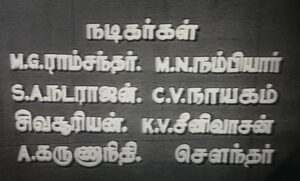
Title credits for Lead actors in Manthiri Kumari. MGR’s name appears as M.G. Ramchandar
Of course, I wanted to complete this film, as it was a very important one for me. It starred the famous actor, M.G. Ramachandran (‘MGR’), who later would become the chief minister of Tamil Nadu. He started his career as a film actor in my first film, Sathi Leelavathi as a raw recruit in the minor role of a police inspector and also acted in Meera and Manthiri Kumari. I could see the improvement in his acting from picture to picture. MGR was a tall, handsome, and athletic type man, admired by all, and became extremely popular with the movie goers. I am proud to say that I played a role in helping his career along. He was a talented and versatile performer and, I understand, a beloved and popular chief minister. At his funeral in 1988 [sic!] it is said that one million people came to pay tribute to him.
For Manthiri Kumari we also had on board the famous screen writer M. Karunanidhi, who, at this writing, is the chief minister of Tamil Nadu. I find it interesting to note that Madras produced two chief ministers and I was delighted to have worked with both of them.
I tried to talk Alice out of leaving India as I was enjoying life there. But in order to save my marriage, I agreed to leave in the middle of the film (which Sundaram I’m happy to say, was able to complete after my departure). Sundaram wanted badly that I stay on to finish the film, and he even offered to double my salary, but Alice said no! So we packed up and boarded the train for Madras, where we tearfully said our farewells to longtime friends. We then traveled to Colombo, Ceylon, where we picked up a ship to New York.”
Dungan on Madhuri Devi – the heroine of ‘Manthiri Kumari’
Madhuri Devi (1927-1990) was the heroine in ‘Manthiri Kumari’. Prior to this movie, she also starred as the heroine of the previous Modern Theater’s production named, ‘Ponmudi’ [Gold Crown], which Dungan directed. This movie, released earlier in the year for Thaipongal, featured the first simulated kiss scene, and which made what Dungan called as ‘infamous’. The script for Ponmudi movie was written by renowned poet Bharatidasan (1891-1964), and the original name of his novel was ‘Ethirparaatha Mutham’ (Unexpected Kiss). As this title was too risque for the Censor board of those days, movie’s title was replaced by the name of the hero in the story.
Dungan’s description of the simulated kiss scene, he directed, and the drama enacted by Madhuri Devi’s father in the set was hilarious, to be omitted. Here is the four paragraphs description of Dungan’s dilemma in the set. As Ponmudi movie was released on January 14th, 1950, the time period of the shooting has to be dated to late 1949. [Words in italics and dots, are as in the original.]
“At Sundaram’s Modern Theaters Studios we stated filming Ponmudi, a social drama. This film created a lot of attention- and criticism – because it introduced the first on-screen embrace between a man and a woman in the history of the Tamil cinema. First I had to be given the authority by the producer, Sundaram, to do the scene. He agreed to it. I had the lead male character, Ponmudi, embracing the lead female character cheek to cheek and rubbing noses but not kissing – something unheard of then – and there was no sign of embarrassment between the actors. Lead actors never kissed in films. If I had allowed my lead characters in the film to kiss on screen, the government’s board of censors would have thrown me out of the country.
The actual love scene was beautifully done by actor Narasimma Bharathi and actress Madhuri Devi. They were seated at a table that revolved on special rollers. The camera was directed at the revolving table allowing the camera to move from face to face. The actor and actress were given a special halo effect. I put a rim light and diffusion filter on both of them, and it was a lovely scene. The revolving table was a technique which, to my knowledge, had never been done before in the history of the Tamil cinema.
During the shooting of this special effect shot, the father of the lead actress happened to stop by the studio and saw his daughter in the arms of the actor. Angrily he barged onto the set, grabbed his daughter, and took her off the premises, all the while shouting, ‘The wedding is off!’ (It seems she was engaged to be married in real life.) Later, after negotiations with the father and Sundaram, the actress eventually came back and completed the film. The father meanwhile was assured there would be only a slight embracing during the scene and that’s as far as it would go. Actually we had enough ‘takes’ to finish the scene even before the father took the daughter away. We were also able to convince the father that this was only a film or ‘make-believe’, and that the scene would not harm his daughter’s good reputation or popularity in any way.
Later, in the theaters, that scene became a big hit…but not with everyone! I stood at the back of the theater when the movie was first shown to the public. As was the custom, the men were sitting on one side of the theater. They loved the scene and laughed and applauded. However, sitting on the other side of the theater were the women, turning away and pulling their saris over their heads.”
Why ‘Manthiri Kumari’ became a big hit in 1950?
Only 13 Tamil movies were released in 1950. That is, roughly one movie per month. Compared to this, 1949 and 1951 saw the releases of 18 and 24 Tamil movies respectively. The 1950 list of movies, in the chronological order of release were,
Krishnavijayam – Jupiter Pictures – Jan. 14th.
Ponmudi – Modern Theatres – Jan.14th
Laila Majnu – Balaji Pictures – Mar. 1st.
Vijayakumari – Jupiter Pictures – Mar. 18th.
Maruthanaatu Ilavarasi – Govindan Co. – Apr. 2nd
Manthiri Kumari – Modern Theatres – June 24th
Ithaya Geetham – Cittadel Film – Jul 29th
Macha Rekai – Sukumar Productions – Aug. 11th
Chandrika – Sri Krishna Productions – Sep. 29th
Thigambara Samiyar – Modern Theatres – Sept. 29th
Ezhai Padum Paadu (adaptation of Hugo’s Les Miserables)– Pakshiraja – Nov. 9th
Parijatham – Lavanya Pictures – Nov. 9th
Among these 13, only 4 (indicated in bold font, above) made ‘waves’ with the then Tamil audience. Three among the 13 movies were produced by Modern Theatres, and two were released under the Jupiter Pictures label. While Ponmudi released for Thai Pongal in January turned out to be a flop (due to its controversial simulated –kiss scene and embrace), Modern Theaters had two hits, in Manthiri Kumari (released in mid year) and Thigambara Samiyar (released in November).
In my view, apart from it’s own merit, three factors indirectly helped Manthiri Kumari’s collections. First was the timely spacing between releases, a vital factor for box office tills to chime. While three movies which were released before Marutha Naatu Ilavarasi failed to excite commoners, with either their plots or lead players, as noted above Ponmudi released under the Modern Theater’s banner, turned out to be controversial and was panned by critics for indecency. This unusual occurrence made the field clear for both of Karunanidhi-scripted MGR movies (Marutha Naatu Ilavarasi and Manthiri Kumari) released one after the other, to have a strong impact. Secondly, singing-action star P.U. Chinnappa (MGR’s senior by 8 months) didn’t have any movies released in 1950. He would suffer an unexpected death following year, at 35. This could have contributed noticeably to MGR’s fortunes. (3) Founding of DMK as an offshoot party from Periyar’s Dravida Kazhagam, in Sept 17, 1949. The plots of two other hits, released in late 1950 – Thigambara Samiyar (by Vaduvoor Duraisamy Iyengar) and Ezhai Padum Paadu (adapted from Victor Hugo’s Les Miserables) – had earned recognition as published novels.
It should also be noted that 1950 saw the death of comedian Kali N. Rathnam (MGR’s mentor in the Madurai Boys Drama company). He died on August 7th, at the age of 52 or 53, probably after hearing word of mouth, that the ‘boy’ he had trained had reached the top stratum in Tamil cinema.
Cited Sources
Ellis Dungan and Barbara Smik: A Guide to Adventure – An Autobiography, Dorrance Publishing Co, Pittsburgh, 2001, pp. 100 – 103.
Kannan: MGR – A Life, Penguin Books, Gurgaon, Haryana, 2017, pp. 68-70.
Karunanidhi M. Nenjukku Neethi, ch.30, vol. 1, Thirumagal Nilayam, Chennai, 1985, pp. 141-142.
Ashish Rajadhyaksha and Paul Willemen: Encyclopedia of Indian Cinema, New revised ed., Oxford University Press, New Delhi, 1998, p. 318.
MGR: Naan Yaen Piranthaen, vol. 2, chapter 101, Kannadasan Pathippagam, Chennai, 2014, pp. 1152-1153.